
There is something fundamentally wrong about the stock market; how do you buy dividend stocks at this valuation?
This is what you usually hear when you are about to invest. Interesting enough, I’m writing this article in May 2019, but I could have written it 2 years ago when I invested over 100K after quitting my job. I could have also written it back in 2014, once most markets had fully recovered from the 2008 crash.
Regardless when you are about to invest, you will likely find more investors telling you the market is overvalued than people saying it’s the best time to put your money in.
Just wait.
If it goes down, wait a little longer.
If it goes up, wait until it goes down.
And what comes around goes around, right? If you follow me for a while, you know that I’m not a believer in timing the market. I’d rather have my money take its time in the market. But this doesn’t mean I buy everything at any price. There is a rigorous stock selection process that needs to be respected if you want to make money investing. This is true when the market is “overvalued” or deeply depreciated. There is no easy way to make your portfolio profitable. This article will detail how I buy dividend stocks whenever I have money on hand. This allows me to never wonder if it’s the right time to buy or to sell; I keep my money in. I let it work for me.
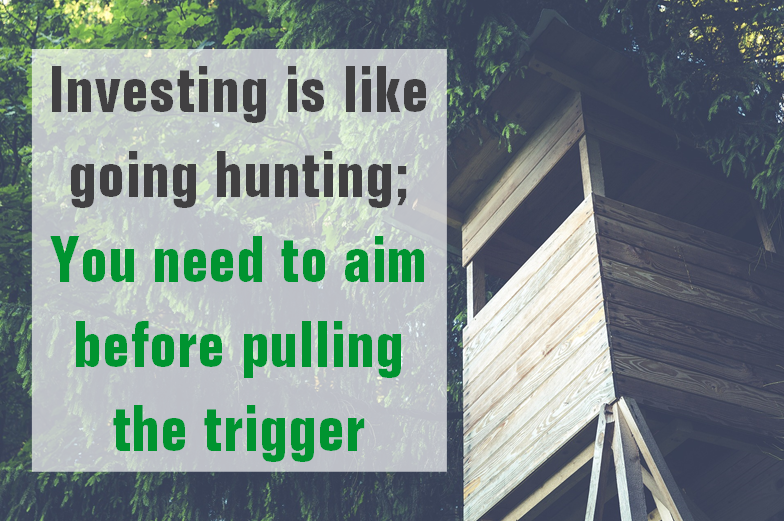
Source: Pixabay
Before pulling the trigger, you need to aim first
Investing your money is like going on a hunting trip. You don’t go screaming and gun blazing through the forest. You take a spot, you make sure you aim, and you shoot only what you want to bring back home.
If you have money ready to get invested, now is the time to invest. But you must aim first. The first step is to build a “watch list”. This is a list of potential stocks that could fit well in your portfolio. When I received the commuted value of my pension plan, I had slightly over 100K to invest. This is a considerable amount of money for a 36-year-old. Since I quit my job to build my business, this pension plan is my cushion in case my business doesn’t fly. I want to make sure this money grows during the next 30 years and become a sizeable nest egg.
At the time I was ready to invest, the US market posted an almost 200% return and the Canadian one posted over a 70% total return. That was in September of 2017:
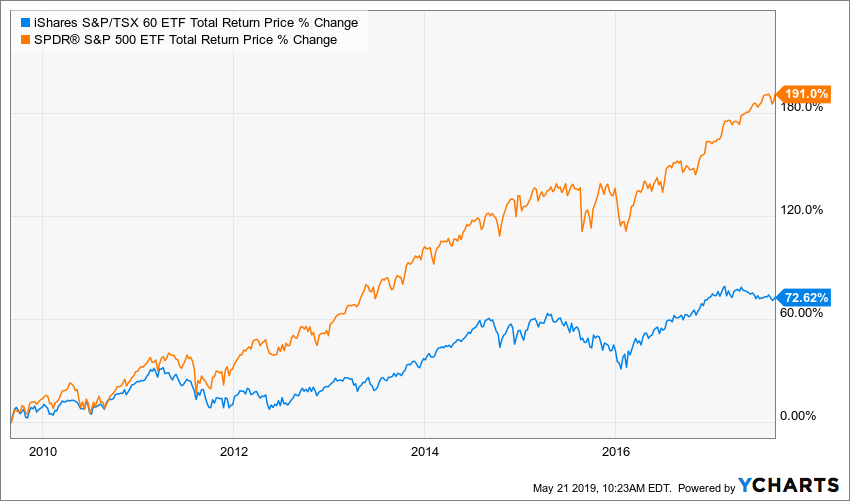
Source: Ycharts
You can imagine the temptation to wait for a drop was great. But instead of waiting for a pullback that never happened (2018 barely brought us back to summer of 2017 for a nanosecond), I got my buy list ready over the summer and when I received my check in September, I was ready to build my dividend growth portfolio. Here are a few tricks I used to buy performing dividend stocks.
Look for dividend growers
Because I needed to start somewhere and because the stock market is such as wide playground, I decided a long time ago to focus on dividend growth stocks. I explained recently why dividend growth investing works even if some index believers think the opposite.
My starting point for any buy list is usually the dividend achievers list. There are over 260 companies showing at least 10 consecutive years with a dividend increase. I prefer this list over the aristocrats and the dividend kings mostly because the list is larger and covers new and upcoming dividend growers.
Companies that are leaders in their market and generate consistent cash flow will likely increase their dividend year after year. Since I have plenty of time before I touch a single penny from my account, I don’t really mind about dividend yield. As long as the payment increases year after year, this is a great start telling me the company is doing something right.
But I couldn’t obviously put 100K into play based on a single metric. This is why I added a few more data to my achievers list.
Add a little more metrics
The first thing I do with my list is to add the dividend triangle metrics. Then again, I keep things very simple. I look for businesses showing growing revenue, EPS, and dividend over the past 3 and 5 years. Those are not unbreakable rules, but focusing on companies with growth vectors (e.g. growing their sales) and profitable (EPS) is an easy way to avoid crappy stocks.
Then, once I’ve highlighted the growth from the list, I make sure my dividend is safe. This is why I add the payout ratio and cash payout ratio. I tend to be “generous” and keep most companies showing both ratios between 10% and 100%. I even sometimes go up to 125% in some cases.
Why would I select companies with a 125% payout ratio? Those companies are definitely about to cut their payment, right? That’s because there are tons of different payout ratios depending on the type of companies you look at. For example, I recently highlighted Enbridge (ENB) as a strong buy on this blog. However, both payout ratios are “through the roof”:
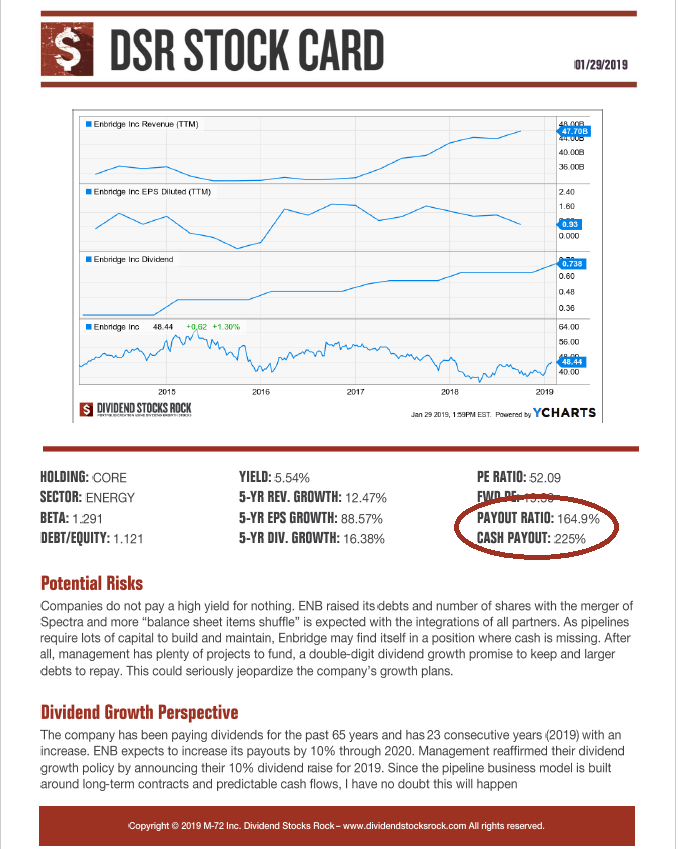
Source: Dividend Stocks Rock stock card analysis
However, when you dig further, you find out that Enbridge (and most pipelines) work with distributable cash flow (DCF). Here’s an example from their investor presentation:
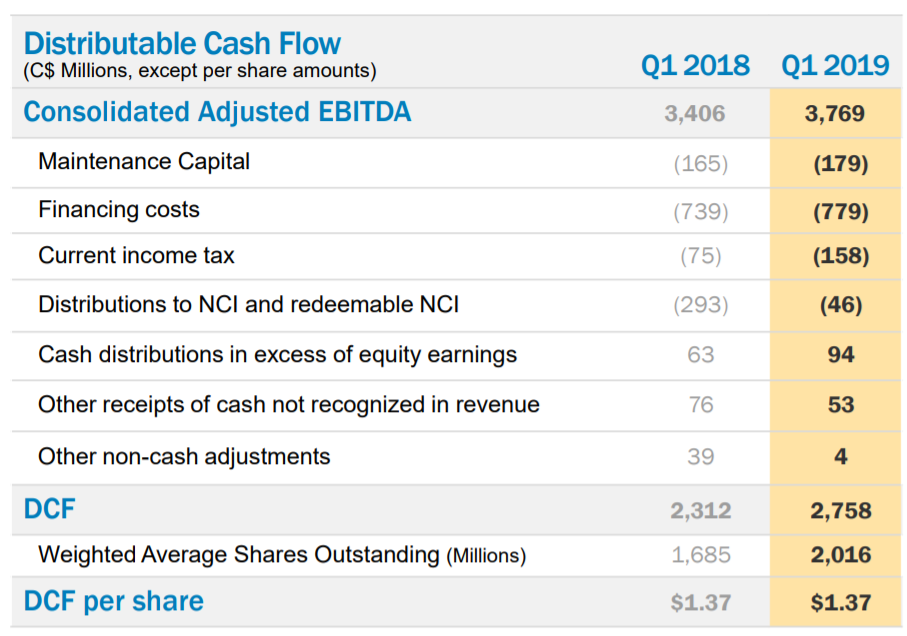
Source
Considering the quarterly dividend paid ($0.738 CAD per share) and the DCF of $1.37, the “real” payout ratio is then 54%. You can now understand a little better why ENB is targeting a 10% dividend growth rate through 2020 and showed a 12.1 annual growth rate for the past 20 years (source). This is a good example of a gem you can find if you overlook over a few metrics.
Always dig deeper
Besides the dividend triangle and two payout ratios, I don’t use other metrics at this point. This quick screen is enough to bring my “stock universe” down from several thousands to a few hundreds. This is where the real work begins.
Lucky for me, I quit my job to create a dividend growth stock research business. Therefore, I don’t need to check stocks one by one as they have already been analyzed by my team and rated accordingly with a PRO rating (sell, hold, buy) and dividend safety score:
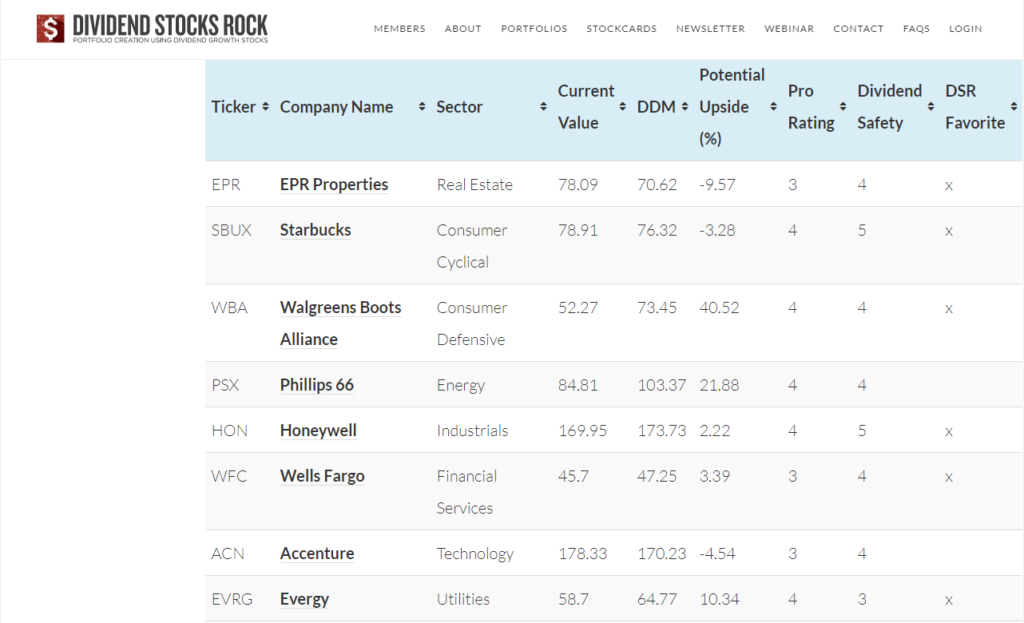
But what I used to do is to go inside each company’s recent quarterly earnings and download their press release, financial statement, and investor presentation. Using those documents, I was in a better position to understand their business model – their strengths along with their weaknesses.
While I’m a super positive person, I tend to spend lots of time on what could possibly go wrong for a company. When it goes well and you make money, you don’t tend to complain, right? When the stock Is down 15%, one must understand what is happening.
After making my mind up about what’s happening with the company and its potential (e.g. identify growth vectors), I usually read a few more articles on the company and look at various metrics such as:
- long-term debt trend
- cash flow from operation trend
- debt-to-equity trend
- price/earnings over the past 10 years
- Use of the dividend discount model
Here are the resources I usually use to find that information:
Ycharts (for all the data)
Morningstar, Motley Fool, and Seeking Alpha (for articles explaining different perspectives)
What I’m looking for when I read other investors’ opinions is their bear thesis. I want to know if I missed something that could hurt my investment. I don’t need to confirm my thesis telling me that company XYZ is a great investment. I want to avoid the confirmation bias.
Build your final list with sector allocation in mind
One thing I found while doing research is that companies in the same sector will tend to all show-up depending on when you pull-out your screener. For example, most chips and analog stocks will not show revenue growth in the past 12 months. Is it a dying industry? No, we are just in the end of an investing cycle where sales are hurt. A few years ago, the very same company would have all shown on top of the “revenue growth list.”
I aim at keeping all sectors below 20% for my portfolio. I currently made two exceptions with Consumer Cyclical (26.1%) and financial services (24.7%) since I have invested in business in different sub-sectors (auto parts, restaurants, entertainment and polymer for consumer cyclical, banks, assets managers and payment processors for financial services).
What I would not do is to buy the 5 biggest Canadian banks for my financial services holdings. Those companies would likely be affected by the same events and having 5 instead of 1 or 2 would not add any diversification.
If I’m unsure about a few stocks in the same sector and I need to pick one, I will usually look at the fair value given by the dividend discount model calculations I previously made. I wouldn’t use the model to trigger a buy or sell, but it’s a good way to compare to similar investing opportunities. Dividend growth perspectives (and sometimes yield) would also play.
Pull the trigger whenever you have money to invest
Many will disagree with me on this final point: buy whenever you can. The reason why I do it with my portfolio is because I can’t predict the future. We all agree that the best time to invest in Microsoft (MSFT) was decades ago. However, nobody wrote that MSFT would skyrocket from to over $125 today back in September 2017.
Since I can’t predict the future and I don’t know when the market will crash by 40% (if it even happens), I decided to focus on what I know: how to select strong dividend growth companies.
Final thought; it’s not black & white and I’m certainly not always doing homeruns
In one of my recent article, I highlight how I believe UPS is a strong candidate for a dividend growth investor portfolio. I have bought shares back in 2017 when I built my pension portfolio. To this date, it is my worst holding at -17.43% (excluding dividend). While my portfolio includes super-powered winners such as Microsoft (+69%), Visa (V) (+50%), Starbucks (SBUX) (+40%), and Disney (DIS) (+32%), UPS is not really making me proud.
Investing is not a black & white science and you will not likely have only winners in your portfolio. The key is to build a strong investing process that will enable you to identify enough winners to grow your portfolio and be patient enough with the ones lagging. As long as my investment thesis remains for UPS, I will hold on to my shares.
Disclaimer: I hold shares of UPS, MSFT, ENB, SBUX, V, DIS
The post A Guide To Buying Dividend Stocks appeared first on The Dividend Guy Blog.
